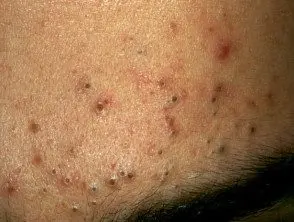What are they comedones?
Comedones are small, skin-colored bumps (papules) is frequently found on the forehead and chin of people with acne. A single injury is a comedo.
- Open comedones are blackheads; black on the surface pigment (melanin), instead of dirt
- Closed comedones are whiteheads; the follicle is completely blocked
- Microcomedones are so small that they are not visible to the naked eye.
- Macrocomedones are closed facial comedones greater than 2–3 mm in diameter.
- A giant comedo is a type of cyst in which there is a clear opening similar to a black dot on the skin
-
Sun comedones are found on the cheeks and chin of older people, and are believed to be due to sun damage.
Comedones

Open comedones

Closed comedones

Giant comedo
What is comedonal acne?
Comedonal acne is an acne pattern in which most lesions are comedones. Comedonal acne most often affects the forehead and chin.
Comedonal acne

Open comedones

Comedonal acne

Comedonal acne
What Causes Comedones?
Comedones arise when the cells lining the sebaceous ducts proliferate (cornification), and increases tallow production. A comedo is made up of debris that blocks the sebaceous duct and hair follicle. Comedones are now known to involve inflammation (See causes of acne).
The development of comedones can involve the following factors:
- Excessive activity of the male. sex hormone 5-testosterone (DHT) inside skin cells
- Reduced linoleate (the salt of the essential fatty acid, linoleic acid) in the sebum causing more scale and reduced barrier function
- Proinflammatory cytokines (cell signaling proteins), such as Interleukin 1 (IL-1) and IL-8, produced by cells lining the follicle in response to activation of the innate immune system
- Free fatty acids made from acne sebum bacteria
- Premenstrually overhydrated skin, from moisturizers or in damp terms
- Contact with certain chemicals, including oils ointments, isopropyl myristate, propylene glycol and some colorants in cosmetics
- Rupture of the follicle from injuries such as squeezing pimples, abrasive scrubbing, chemical peels or To be deals
-
Smoking: Comedonal acne is more common in smokers than non-smokers
- Certain dietary factors can contribute to comedonal acne, particularly dairy products and foods with a high glycemic index (sugars and fats)
What is the treatment for comedonal acne?
If you have comedonal acne, choose oil-free cosmetics and wash them twice a day with mild soap and water. It is better to quit smoking and eat a diet low in sugar, fat, and dairy.
Choose "comedolytic" current Medications These should be applied once or twice a day as a thin spot all over the affected area. It may take several weeks or months for a worthwhile improvement to occur. Treatment must be continued long term (sometimes for many years).
Suitable topical agents include:
- Benzoyl peroxide
- Azelaic acid
-
Salicylic acid +/- sulfur and resorcinol
- Glycolic Acid
- Retinoids such as tretinoin, isotretinoin, adapalene (these require a prescription)
Oral medications prescribed for comedonal acne include:
- Hormonal therapy
- Isotretinoin
Antibiotics can also improve comedonal acne, but are usually prescribed for inflammatory acne (acne vulgaris)
Surgical treatments are sometimes recommended to remove persistent comedones:
- Cryotherapy
-
Electrosurgery (cauterization or diathermy)
- Microdermabrasion
Electrosurgery for closed comedones

Comedone electrosurgery
